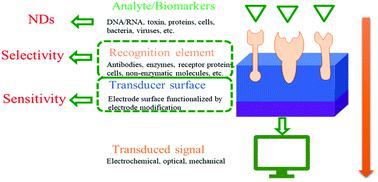当前位置:
X-MOL 学术
›
J. Mater. Chem. B
›
论文详情
Our official English website, www.x-mol.net, welcomes your
feedback! (Note: you will need to create a separate account there.)
Recent advances in enzymeless-based electrochemical sensors to diagnose neurodegenerative diseases
Journal of Materials Chemistry B ( IF 6.1 ) Pub Date : 2021-1-5 , DOI: 10.1039/d0tb02745f Zeyu Song 1, 2, 3 , Ying Zhou 1, 2, 3 , Xiao Han 1, 2, 3 , Jieling Qin 3, 4, 5 , Xiaoying Tang 1, 2, 3
Journal of Materials Chemistry B ( IF 6.1 ) Pub Date : 2021-1-5 , DOI: 10.1039/d0tb02745f Zeyu Song 1, 2, 3 , Ying Zhou 1, 2, 3 , Xiao Han 1, 2, 3 , Jieling Qin 3, 4, 5 , Xiaoying Tang 1, 2, 3
Affiliation

|
The use of sensitive electrochemical sensors to detect biomarkers is an effective method for the early diagnosis of several neurodegenerative diseases (NDs), such as Alzheimer's disease, Parkinson's disease, Huntington's disease, amyotrophic lateral sclerosis, etc. However, the commercialization of enzyme/aptamer-based sensors is still hampered owing to the historic drawbacks of biorecognition elements including high cost, poor stability, and complex integration technology. Non-enzymatic electrochemical sensors are more attractive compared to their traditional counterparts and can be widely harnessed owing to their low cost, high stability, sensitivity, and ease of miniaturization. This review summarizes recent research progress focusing on the construction of non-enzymatic electrochemical sensors and analyzes their present use in the early diagnosis of NDs. Additionally, this review addresses the limitations and challenges of the use of current non-enzymatic electrochemical sensor technologies for the diagnosis of NDs and highlights the possible directions for future research.
中文翻译:

基于无酶的电化学传感器诊断神经退行性疾病的最新进展
使用灵敏的电化学传感器检测生物标志物是早期诊断几种神经退行性疾病(ND)的有效方法,例如阿尔茨海默氏病,帕金森氏病,亨廷顿氏病,肌萎缩性侧索硬化症等。然而,由于生物识别元件的历史性缺点,包括高成本,稳定性差和复杂的整合技术,基于酶/适体的传感器的商业化仍然受到阻碍。与传统传感器相比,非酶电化学传感器更具吸引力,并且由于其低成本,高稳定性,灵敏性和易于小型化而可以广泛使用。这篇综述总结了侧重于非酶电化学传感器构建的最新研究进展,并分析了它们在ND早期诊断中的应用。此外,本综述解决了使用现有的非酶电化学传感器技术诊断ND的局限性和挑战,并强调了未来研究的可能方向。
更新日期:2021-01-18
中文翻译:

基于无酶的电化学传感器诊断神经退行性疾病的最新进展
使用灵敏的电化学传感器检测生物标志物是早期诊断几种神经退行性疾病(ND)的有效方法,例如阿尔茨海默氏病,帕金森氏病,亨廷顿氏病,肌萎缩性侧索硬化症等。然而,由于生物识别元件的历史性缺点,包括高成本,稳定性差和复杂的整合技术,基于酶/适体的传感器的商业化仍然受到阻碍。与传统传感器相比,非酶电化学传感器更具吸引力,并且由于其低成本,高稳定性,灵敏性和易于小型化而可以广泛使用。这篇综述总结了侧重于非酶电化学传感器构建的最新研究进展,并分析了它们在ND早期诊断中的应用。此外,本综述解决了使用现有的非酶电化学传感器技术诊断ND的局限性和挑战,并强调了未来研究的可能方向。











































 京公网安备 11010802027423号
京公网安备 11010802027423号